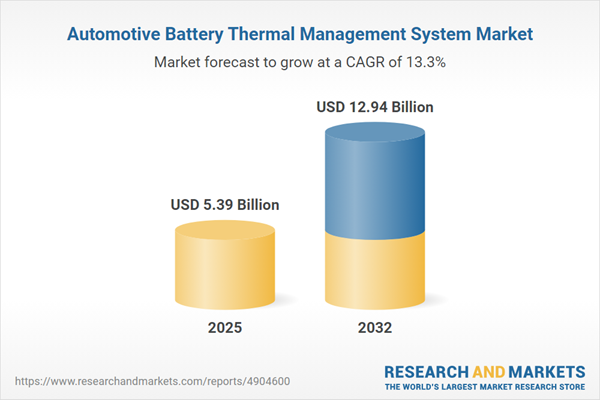Speak directly to the analyst to clarify any post sales queries you may have.
The automotive battery thermal management system market is experiencing significant transformation as electrification accelerates and stringent requirements reshape supply chains, product development, and regional strategies. Senior leaders need focused insights to navigate evolving operational risks and capture new opportunities in this sector.
Market Snapshot: Automotive Battery Thermal Management System Market Growth
The global automotive battery thermal management system market advanced from USD 4.76 billion in 2024 to USD 5.39 billion in 2025. Sustained momentum is forecasted, with a CAGR of 13.31%, and the market is set to reach USD 12.94 billion by 2032. Key growth drivers include the rapid adoption of electric vehicles, increased regulatory attention on battery safety, and growing consumer demand for better battery performance and lifespan.
Scope & Segmentation
This comprehensive report analyzes the automotive battery thermal management system landscape by reviewing emerging technologies, customer segments, and regional trends. Each segment highlights strategic priorities for industry players and supports benchmarking initiatives:
- Product Types: Includes active systems providing dynamic, real-time cooling, and passive solutions favoring simplicity for budget- and weight-sensitive vehicles.
- Cooling Methods: Covers air cooling, both direct and indirect liquid cooling, as well as phase change solutions, each offering distinct benefits in terms of efficiency, integration, and cost.
- Installation Levels: Addresses deployment across cell, module, and pack levels, aligning with the need for modularity and rapid adaptation to changing vehicle architectures.
- End Users: Spans both passenger vehicles and commercial fleets, with differentiated priorities such as efficiency, system integration, and lifecycle costs.
- Regions: Encompasses Americas (including major economies and emerging automotive hubs), Europe, Middle East & Africa (featuring established and emerging markets), and Asia-Pacific (home to leading battery manufacturing and electric vehicle growth markets).
- Companies: Profiles include DENSO Corporation, Valeo SA, MAHLE GmbH, Hanon Systems, Gentherm Incorporated, BorgWarner Inc., Webasto SE, Behr GmbH & Co. KG, Setra Systems Inc., and Robert Bosch GmbH, providing insight into both established and fast-scaling players.
Key Takeaways for Senior Decision-Makers
- Thermal management solutions are leveraging increasingly advanced digital controls and analytics to ensure batteries within electric vehicles operate safely and efficiently across diverse duty cycles.
- Technology selection varies by vehicle type—active systems dominate high-performance markets, while passive configurations are optimized for models where cost and simplicity remain priorities.
- Emerging material technologies, such as microchannel structures and advanced interface components, are helping manufacturers meet evolving regulatory and operational requirements for conductivity and reduced system mass.
- OEMs are adopting modular system architectures that allow for rapid reconfiguration and scalability, enabling quicker launches across multiple vehicle lines and enhanced supply agility.
- Strategic regional focus adapts thermal solutions for local climates, charging patterns, and evolving regulatory standards, while proximity to emerging manufacturing hubs supports supply optimization.
Tariff Impact: United States Trade Policy and Cost Structure Adjustments
The introduction of United States tariffs on imported automotive components in 2025 has increased complexity across battery thermal management system supply chains. These policies have elevated input expenses for imported heat exchangers and raw materials, prompting changes in supplier contracts and investments in alternative sourcing, such as nearshoring. Industry players are now accelerating collaboration between battery and thermal specialists to drive module standardization and regulatory compliance, supporting resilience and diversification throughout the network.
Methodology & Data Sources
This report employs a robust, multi-phase research process. It features interviews with engineers, regulatory experts, and procurement leaders, supported by analysis of technical publications, patent filings, and cost-performance benchmarks. All findings are rigorously validated through triangulation across established industry sources.
Why This Report Matters
- Provides data-driven insights to align product and sourcing decisions with new regulatory and market requirements, reducing risk during technology transitions in battery thermal management systems.
- Enables operation and procurement leaders to anticipate and mitigate supply chain disruptions in volatile trade conditions, supporting scalable, flexible supply strategies.
- Equips executive teams to benchmark existing solutions, optimize system choices for evolving electric vehicle markets, and drive greater operational value.
Conclusion
Battery thermal management systems are now central to safe, efficient, and adaptable electric vehicle delivery. Executive readiness to implement innovation and proactive supply adaptation will define leadership in this evolving market.
Additional Product Information:
- Purchase of this report includes 1 year online access with quarterly updates.
- This report can be updated on request. Please contact our Customer Experience team using the Ask a Question widget on our website.
Table of Contents
3. Executive Summary
4. Market Overview
7. Cumulative Impact of Artificial Intelligence 2025
List of Figures
Samples

LOADING...
Companies Mentioned
The key companies profiled in this Automotive Battery Thermal Management System market report include:- DENSO Corporation
- Valeo SA
- MAHLE GmbH
- Hanon Systems
- Gentherm Incorporated
- BorgWarner Inc.
- Webasto SE
- Behr GmbH & Co. KG
- Setra Systems Inc.
- Robert Bosch GmbH
Table Information
| Report Attribute | Details |
|---|---|
| No. of Pages | 191 |
| Published | October 2025 |
| Forecast Period | 2025 - 2032 |
| Estimated Market Value ( USD | $ 5.39 Billion |
| Forecasted Market Value ( USD | $ 12.94 Billion |
| Compound Annual Growth Rate | 13.3% |
| Regions Covered | Global |
| No. of Companies Mentioned | 10 |









